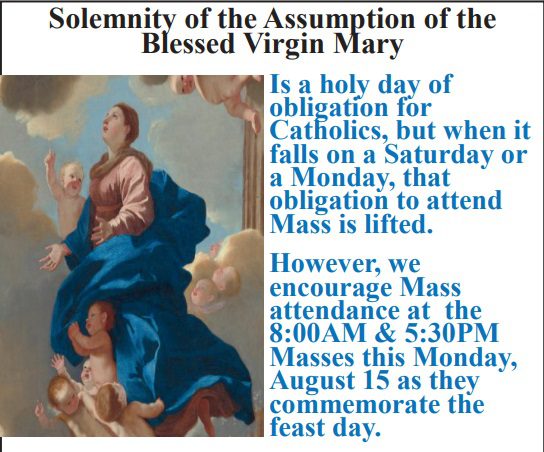
This solemnity celebrates the fact that
Mary’s Assumption is “a pledge of the future
participation of the members of the mystical
Body of Christ in the paschal glory of the Risen Christ.” It shows that the Lord “reserves a
munificent reward for his humble Servant
because of her faithful cooperation with the
divine plan, which is a destiny of fullness,
happiness, glorification of her immaculate
soul, her virginal body, perfect configuration
to her Risen Son” (Directory, no. 180).
What does this all mean? On November
1, 1950, Pope Pius XII declared the Assumption of the Blessed Virgin Mary, which the
Church celebrates every year on August 15.
Simply put, the dogma of the Assumption
states that at the end of her life, the Blessed
Virgin Mary was taken, body and soul, into
Heaven. While this event isn’t reflected in Sacred Scripture, it is clearly part of the Church’s
earliest observance. In the sixth century, St.
John Damascene wrote in one of his sermons,
“Your sacred and happy soul, as nature will
have it, was separated in death from your most
blessed and immaculate body, and although the
body was duly interred, it did not remain in the
state of death, neither was it dissolved by decay; your most pure and sinless body was not
left on earth, but you were transferred to your
heavenly throne.”
The Solemnity of the Assumption reminds us of the unique role that Mary served
in the process of our salvation. Although she
was without sin, we have the possibility of receiving God’s forgiveness for our sins through
Christ. Her entry into Heaven prefigures our
own hope of experiencing the same eternal
life.
What is the Assumption? is an excerpt from the Essential Guide to Seasons and Saints, copyright © 2013,
United States Conference of Catholic Bishops, Washington, DC. All rights reserved. What does this all
mean? was written by Fr. Larry Rice, former vocations director for the Paulist Fathers. Copyright © 2018,
United States Conference of Catholic Bishops, Washington DC. All rights reserved.
